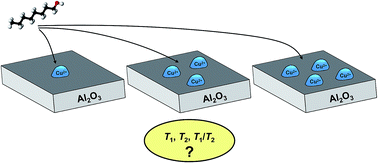Effect of paramagnetic species on T1, T2 and T1/T2 NMR relaxation times of liquids in porous CuSO4/Al2O3
Abstract
The presence of paramagnetic species has a well-known strong effect on the NMR relaxation times of liquids. This is well-known in solution but it is also the case when liquids are confined in porous materials containing paramagnetic impurities deposited over solid surfaces, such as ions of certain metals. In the literature only a few studies have been conducted on this subject. In particular, the effect of paramagnetic impurities on the ratio of relaxation times, T1/T2, has not been fully elucidated and the few published results are somehow still fragmentary and in some cases inconsistent. Yet, a clear understanding of this behaviour is crucial in order to further extend and implement NMR relaxation techniques to study surface interactions in porous materials, in particular porous catalysts, where paramagnetic species can be present as residual impurities from the catalyst manufacturing processes or as a part of the active catalytic components. In this work, the effect of small amounts of paramagnetic species deposited over the surface of porous solids on NMR relaxation times has been investigated for a variety of CuSO4-doped alumina samples, in order to understand the behaviour of T1, T2 and particularly the ratio T1/T2 as a function of paramagnetic species content. The results show that the single values of the fluid relaxation times are strongly affected by the presence of paramagnetic impurities deposited over the solid surface, with the relaxation rates 1/T1 and 1/T2 being proportional to the content of paramagnetic ions, as expected from theory; conversely, the T1/T2 ratio does not change significantly. This is in line with some theoretical considerations and some previous results reported in the literature, suggesting that whilst single values of T1 and T2 are strongly affected by the presence of paramagnetic relaxation sinks, the T1/T2 ratio is to a large extent independent of their concentration at the surface, whilst it depends on changes in molecular mobility due to changes in strength of surface interactions, which affect the surface correlation and residence times.



 Please wait while we load your content...
Please wait while we load your content...